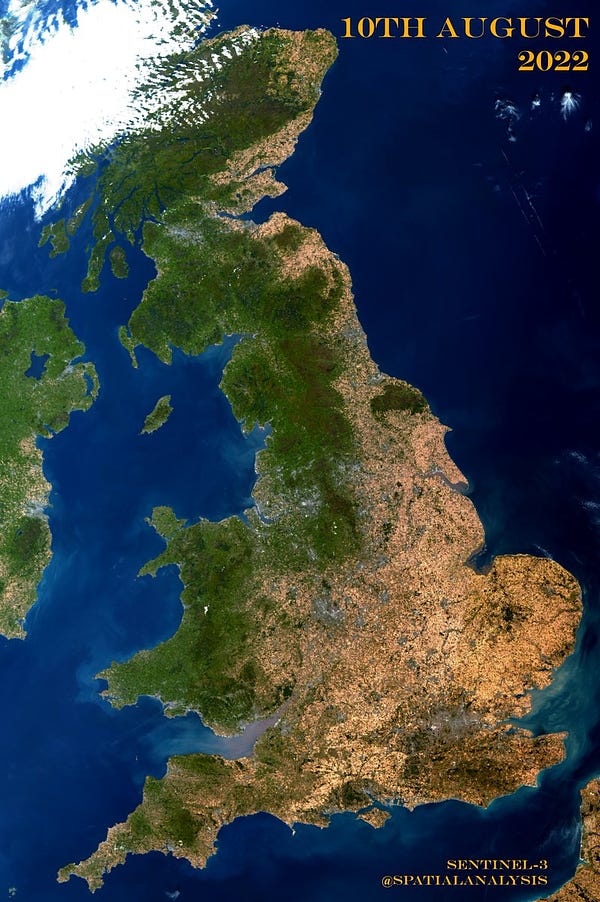Welcome to the mid-week update from New World Same Humans, a newsletter on trends, technology, and society by David Mattin.
If you’re reading this and haven’t yet subscribed, join 22,000+ curious souls on a journey to build a better future 🚀🔮
To Begin
This week, tech giant NVIDIA launch a new tool that empowers users to build their own AI-fuelled avatars.
Meanwhile, Europe’s exceptionally hot and dry summer is a troubling signal of what lies ahead. And biometrics are creeping ever deeper into our lives, courtesy of Amazon, the US government, and others.
Let’s go!
🦸♂️ Avatars assemble
This week, another onrush of metaverse news.
US tech giant NVIDIA launched their new Avatar Cloud Engine, a cloud-based toolkit that help users build their own ultra-realistic virtual humans.
The tools form part of NVIDIA’s Omniverse Avatar platform, which I wrote about back in New Week #60; they’re intended to democratise access to the massive computing power needed to build AI-fuelled avatars.
NVIDIA, then, continue to double-down on their vision of a consumer arena filled with virtual humans that can play a wide range of roles, from drive-thru staff, to customer service assistants, to counsellors.
Meanwhile, headlines were generated this week by the ongoing land price crash inside popular metaversal worlds. The average price of land sold in Decentraland peaked at $37,238 in February; by 1 August that had fallen to just $5,163. The drop prompted Business Insider to announce that ‘the metaverse hype seems to be fading’.
⚡ NWSH Take: Two metaverse stories; two contradictory messages. NVIDIA is investing heavily in a strategy founded on the idea that virtual worlds — and virtual humans — will soon be a part of all our lives; for more on that see see Kim Kardashian, Virtual Humans, and How Weird Becomes Mainstream. Meanwhile, some technology journalists are rushing to argue that the metaverse bubble has burst. What’s going on? // What bedevils so much discussion of the metaverse right now is the lack of any clear definition. In particular, this week’s suggestion that the metaverse was maybe just hype all along is founded on a set of overlapping and wrong ideas. // The metaverse isn’t Decentraland or Roblox. Instead, as Tim O’Reilly argued this week, the metaverse is best understood not as a place but as a medium. I’ve come to think of it as the emergence of a new kind of internet; one in which people are having experiences that are as meaningful to them, in some sense as real to them, as the experiences they have IRL. // Internalise this definition, and the complexion of the land price story changes. Back in the early days of the web, brands such as Netscape and AltaVista peaked and then flamed out. We’ll see the same with key metaverse platforms in the 2020s. But the medium itself is here to stay, because — just as with the internet — it unlocks powerful new ways to serve fundamental human needs.
🏞 Take me to the river
Here in the UK we’re entering another heatwave, just three weeks after temperature records were shattered across the country.
This week, new satellite images showed the toll this heat has taken; vast swathes of the UK have been reduced to a charred yellow that is exceptional even for the height of summer:


Anecdotally, I can relate: I live close to a large grass heath in southeast London, and I’ve never seen it so battered by heat.
A madly hot and dry summer means many rivers in central and southern England are running exceptionally low.
And recent satellite images show the same is true across much of mainland Europe; see these images, for example, that show the river Po in Italy is close to drying up in places. Northern Italy is currently experiencing its worst drought for more than 50 years. Meanwhile, Spain is experiencing a prolonged dry spell that has seen reservoirs ‘hit rock bottom’. Check out this Twitter thread for a rundown of the many ways the insane heat has disrupted Europe this summer.
This week the head of the European Space Agency, Josef Aschbacher, warned that the economic impacts of climate change will come to dwarf those of the current energy crisis.
⚡ NWSH Take: This newsletter has harped on, recently, about the coming reality that is adaptation to a heated world. Regular readers can no doubt recite the central argument: the 1.5C target is out of reach, and adaptation is our last and only option. // But the welter of satellite images depicting a climate-deranged Europe in recent weeks are a reminder that adaptation will prove far easier to talk about than it will to enact. The cartoon version of a climate-doom future is one in which it wipes out humanity, or something close. That’s possible, but unlikely; for a deeper investigation see this new paper from University of Cambridge researchers, which argues that we haven’t done enough to investigate the possibility of catastrophic heating. But I’m increasingly convinced that our current energy woes are only a foreshock that signals the coming of a mighty earthquake: a WWII-level economic and social convulsion that shreds agriculture, energy, transport and more. // If that turns out to be the case, then the only way out will be through. We need to ready ourselves collectively and individually for what is coming. And we need to start thinking about what we want our societies to look like, who we want to be, when we get to the other side.
🤚 Hand it to you
Three stories combined this week to form a signal of a coming age of biometrics.
Amazon announced that it will bring Amazon One palm-scanning payment devices to 65 Whole Food stores in California — the biggest roll-out of the technology so far. The device requires that users first link a scan of their palm to a payment card; last year a group of US senators sent a letter to CEO Andy Jassy asking for clarity on how Amazon plans to store palm scans, and how else it might use them.
Meanwhile, the UK Home Office said it will soon require migrants convicted of crimes to scan their faces up to five times a day. These migrants will wear smartwatches equipped with facial recognition technology, which will also track their location 24/7.
And finally, news emerged this week that several cities in the US are rolling back previous bans on use of facial recognition by police. New Orleans, for example, instituted a ban in 2020, but decided in July to change course and allow police to use the technology when investigating violent crime. A similar ban was issued in California in 2020; it’s due to expire this year and attempts to make it permanent have failed.
⚡ NWSH Take: There’s nothing entirely new going on here; rather, this is a story about slow accumulation. Biometrics have crept their way into daily life across the last decade; a staging post was crossed when many of us began to access our phones via facial recognition. // But these happenings are a signal of how early we are in that story — of how much deeper biometrics are set to weave themselves into the fabric of our lives in the 2020s. Two fundamental human impulses are driving all this. On the consumer side, it’s the impulse towards convenience; Amazon One is just the latest in a long line of innovations intended to make shopping as easy as breathing. On the organisational side — that means business and government — it’s the impulse towards control. Amazon wants to know everything about you, so it can leverage that knowledge to shape your behaviours and make you predictable. Data is the key that unlocks this knowledge; see also Amazon’s $1.7 billion acquisition of iRobot, makers of the in-home Roomba robot vacuum. // Underlying all this is a deeper question. How much of our freedom are we willing to give up for yet more convenience? Across the last two decades, and step by step, we’ve acquiesced to a settlement with Big Tech that allows them vast oversight of our lives, and huge unaccountable power. But there’s still time to remake this settlement — to put the break on biometrics — if we can muster the collective will. For more, revisit The Tyranny of Convenience.
🗓️ Also this week
☀️ NWSH reader Giulia Camargo created an online tool that allows users to calculate how much energy and money they’ll save if they turn down their AC. The tool is a response to last week’s new directive in Spain, which bans public spaces from setting the AC below 27C.
👨⚕️ TikTok parent company ByteDance paid $1.5 billion for China-based Amcare Healthcare. Founded in Beijing in 2006, the company offers private medical services and operates hospitals. ByteDance didn’t elaborate on this expansion into healthcare. But it comes weeks after Amazon’s $3.9 billion acquisition of One Medical.
🚲 Food delivery company Deliveroo says it may leave the Netherlands. The company cites poor results in the country. But regulatory changes are also shaping the company’s future; the EU is mulling new regulation of gig economy platforms that would see many of their workers recognised as full employees.
🚕 Chinese tech giant Baidu has gained permission to run driverless taxis in Wuhan and Chongqing without a safety driver in the car. This marks the first time permits have been issued for fully driverless cars on Chinese roads. Also this week, video emerged showing a driverless Tesla ploughing through a cardboard-cutout child in a safety test. It’s unclear whether Tesla’s self-driving technology was in operation during the test.
📱 The number of US teens who say they are online ‘almost constantly’ has doubled since 2014. According to Pew Research, back in 2014 only 24% of teens reported spending most of their time online; now that figure is 46%. YouTube was the most popular platform among respondents, used by 95%; TikTok came second, with 67% of US teens saying they use it.
🤖 Meta launched Atlas, a new AI language model that outperforms much larger models on question answering and fact checking tasks. Atlas is augmented by a knowledge base that it can search to help it handle factual questions.
⚖️ A US federal judge says AIs cannot hold patents. In a case involving computer scientist Stephen Thaler and his quest to assign patents to AIs he has created, Judge Leonard P. Stark noted that US law is clear that only people can hold patents.
🤩 Virtual reality can cause experiences of transcendence that mimic those caused by LSD according to a new study. A VR experience called Isness-D produced the same effects as a medium dose of LSD on four key response indicators commonly used in studies of the drug. The experience sees participants take the form of a cloud with a ball of light at its centre.
🌍 Humans of Earth
Key metrics to help you keep track of Project Human.
🙋 Global population: 7,966,973,562
🌊 Earths currently needed: 1.7866509248
💉 Global population vaccinated: 61.9%
🗓️ 2022 progress bar: 61% complete
📖 On this day: On 12 August 1981 the IBM Personal Computer is released. The first microcomputer in the IBM PC line, it sets the template for the personal computing revolution of the 1980s and 90s.
Face to Face
Thanks for reading this week.
The creep of biometrics technologies into our lives is a slow-motion collision between new technologies and age-old human needs. A classic case of new world, same humans.
This newsletter will keep watching, and working to make sense of it all. And there’s one thing you can do to help: share!
Now that you’ve made it to the end of this week’s instalment, why not forward the email to someone who’d also enjoy it? Or share it across one of your social networks, with a note on why you found it valuable. Remember: the larger and more diverse the NWSH community becomes, the better for all of us.
I’ll be back next week. Until then, be well,
David.
P.S Huge thanks to Nikki Ritmeijer for the illustration at the top of this email. And to Monique van Dusseldorp for additional research and analysis.















New Week #94